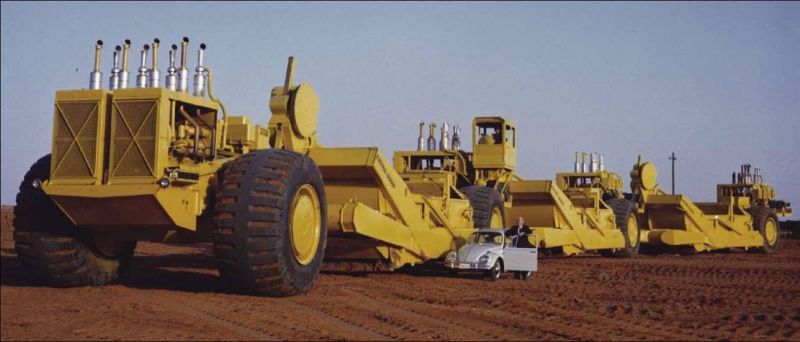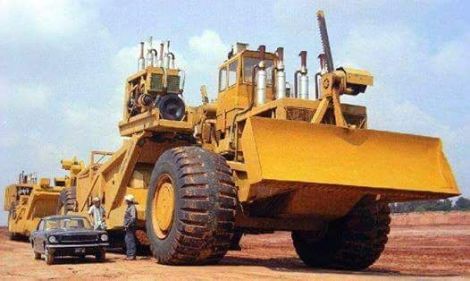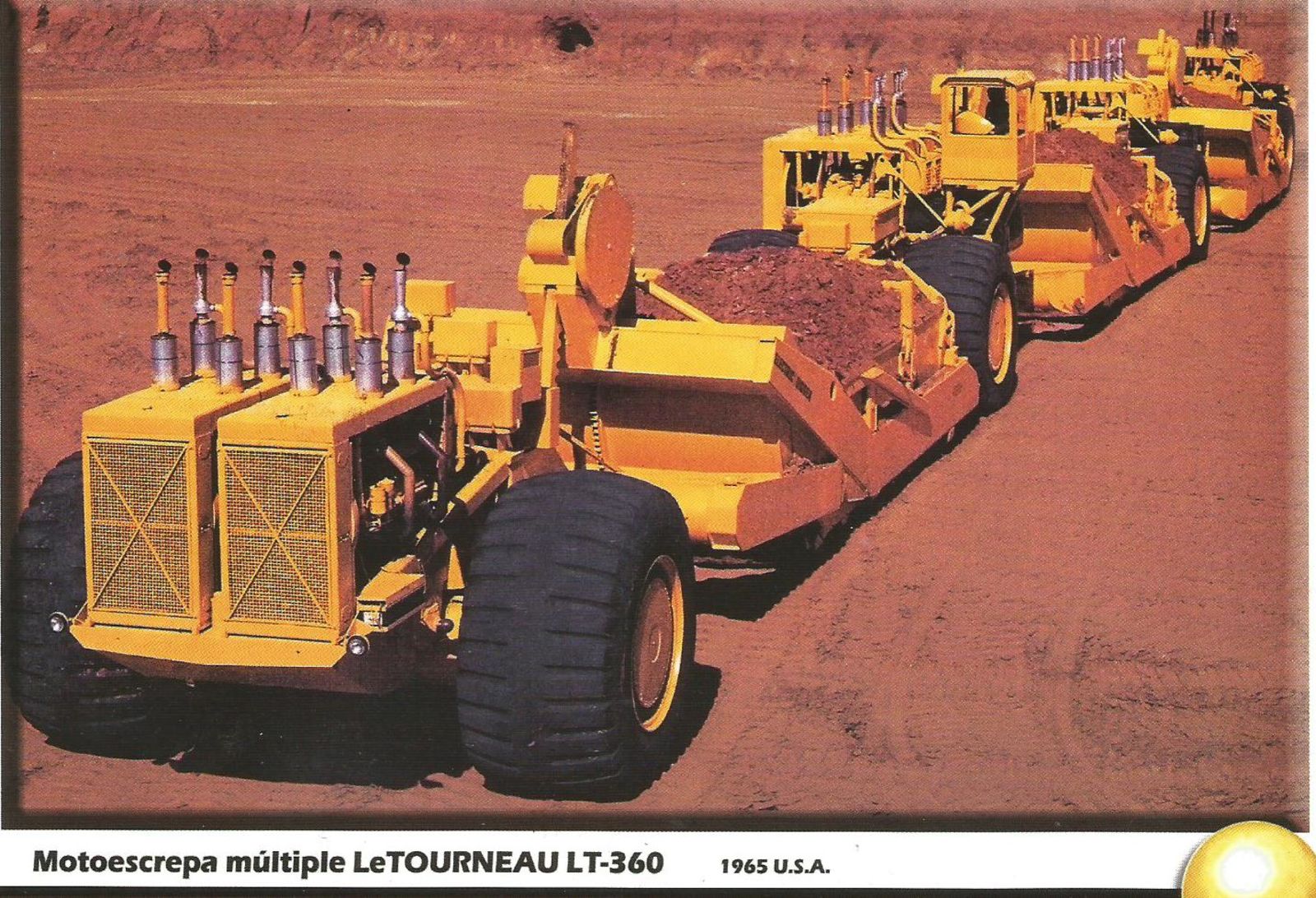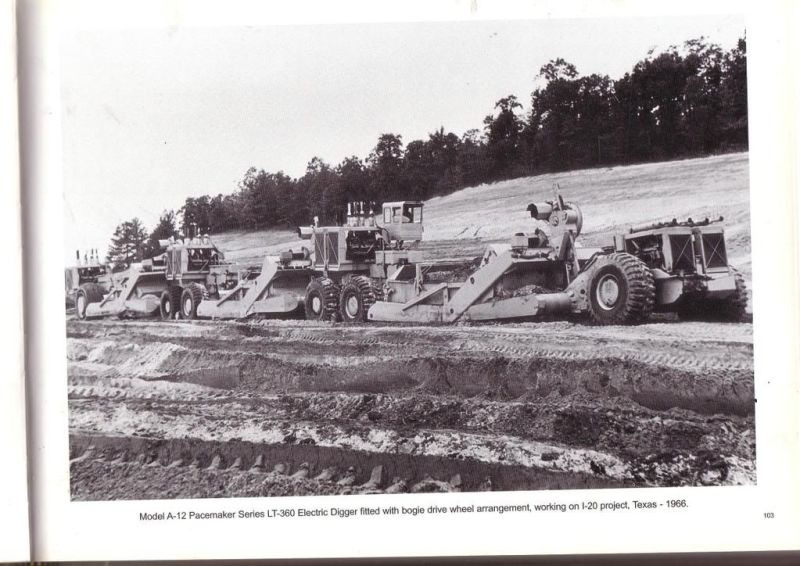Look at this thing!

I mean, I know Volkswagen Beetles aren’t the largest of cars, but that’s still pretty huge.
So... As odd as it sounds, this monster was actually built with the intention of saving money. The reasoning was that the bigger the scraper, the more it can scrape at once, the faster you can finish scraping, the more money you save. It started life as a prototype called the Lt-120, which was the first of the three sections that would make up the Lt-360. It had two 12-cylinder Detroit Diesel 12V engines up front, two 16-cylinder Detroit Diesel 16V-71 engines out back, and a diesel-electric drivetrain sending power to the wheels. Combined, the gross horsepower rating was 2,220. The cutting edge of the scraper bowl was a whopping 14 feet and 2 inches, one of the largest ever designed for a machine like this, and the payload capacity was rated at 72 cubic yards and 120 tons. But LeTourneau decided it could still be bigger.
In 1965, they added a second 72-yard scraper unit to the back of the Lt-120, and named the new configuration the Lt-240. This new scraper was identical in design to the first, with the exception of the engine configuration being changed. Changes to the Lt-120 included removal of the rear engines, and the addition of a cab for the operator. The second scraper had two Detroit Diesel 16V-71 engines at the rear, but no engines or driven wheels at the front, since it was being towed by the Lt-120. The Lt-240 now had 2,855 gross horsepower and was already freaking massive, but LeTourneau still thought it could be a bit bigger.

And so we arrive at the utterly gargantuan Lt-360, the mother of all scrapers.

There was more to the creation of the Lt-360 than just the addition of a third scraper unit, though. More engineering was required to give it enough structural integrity and power to handle a third section. The yoke attaching the front drive unit to the scraper bowl was given stronger welds and more metal braces, as the twisting, torsional stresses of traveling over uneven ground with that much of a burden was taking its toll on the old design. The cab was relocated to the rear of the lead scraper unit to give the operator a better view of all three segments. The third section was added between the Lt-240's front and rear sections, and had two more Detroit Diesel 16V-71 engines, sending power to (I think) the rear wheels of the front section, while the front section’s engines powered the front wheels. A fourth bank of engines was also added, so now it had one engine for every two wheels, six of which are 16-cylinders and two of which are 12-cylinders, and 12 wheel drive. (Yes, most of these pictures only show it having 8 wheels, but originally it had 12. The reason why is that it was later redesigned, and there are more photos of the redesigned version which only had 8 wheels. I only found one photo of the original 12-wheeled version.)

It now had 4,760 gross horsepower and could carry a record-breaking 216 cubic yards of dirt, weighing in at 360 tons. That’s a whole lotta dirt.
In July of 1965, it was finally given the chance to prove itself in a real working environment. Two miles east of the Sabine river, a sizeable road construction project was underway on highway 20 in east Texas, and LeTourneau had gotten the contract to work on a two-mile stretch across the Sabine river bottom.
A large amount of dirt was needed to raise the road above any recorded flood levels. Some of this dirt came from the hills west of the river, and some of it was to come from the two-mile stretch of riverbed. I think. Honestly, I don’t actually understand what they were trying to do at this point, but what’s important was that LeTourneau got a contract to excavate a crap-ton of dirt out of a two-mile stretch of riverbed, and they brought every earth-moving machine they could spare to do so. They saw it as an exhibition of what their creations were capable of, figuring it would be excellent publicity. Even though it was still in the design stage, they brought the massive Lt-360 to the site to see what it was capable of.
Before long, it was filling itself with 360 tons of dirt in as little as 80 seconds. It had a traveling speed of about 15-20 mph as it drove to the work site, and it could unload itself in about 40 seconds, spreading the dirt at a depth of about 8-10 inches. The inertia of the dirt as it was scooped would actually cause it to jump into the bowls. By December 10th, LeTourneau had finished the job, and in record time.
Although the Lt-360 had shown impressive performance, they did notice some problems with it. The 12-wheeled design gave it an enormous turning circle, which made maneuvering it into position rather difficult. Not only that, but the tires ended up not being wide enough for such a large vehicle, which occasionally caused problems when conditions were not ideal. After the excavation was finished, the Lt-360 was brought back to the factory for modifications. Unveiled in March, 1966, the updated Lt-360 had only eight wheels to allow the hitches more freedom, thus improving the turning radius, as well as newly-designed wider tires to help support the immense weight. This time, all eight engines were Detroit Diesel 16V-71's, giving it 5,080 gross horsepower. The previous version had been 175 feet long, but despite having fewer tires, the new version was 200 feet long. To this day, it is the most powerful scraper ever built, and has the highest payload capacity as well.
But although its immense size came with impressive performance, it also made potential buyers nervous. Its great length and width necessitated extensive disassembly every time it was to be transported on public roadways, adding cost and time, as well as mountains of trucking paperwork. The size also limited its usefulness in all but the largest projects, which limited the appeal even more. In the end, it was not a success at all. They tried to design a more modest 148 foot-long two-sectioned Lt-300 in the hopes that it would attract more customers, but it soon became clear that there was no money in building giant scrapers, and the project was scrapped.
But even though the Lt-360 was a failure, it was definitely a very interesting idea. And if you ask me, it was the most magnificent scraper ever built.